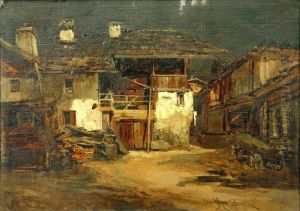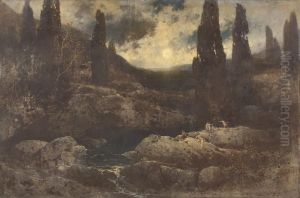Max Bruckner Paintings
Max Bruckner, born on June 6, 1836, in Kronach, Bavaria, was a German artist whose work primarily focused on landscape painting. He was part of the 19th-century art movement that sought to capture the natural beauty of the countryside, a theme that was becoming increasingly popular among artists and patrons during this period. Bruckner's paintings are characterized by their detailed depiction of nature, vibrant colors, and the ability to convey the serene and majestic aspects of the landscapes he chose as his subjects.
Bruckner studied art at the Academy of Fine Arts Munich, one of the most prestigious art schools in Germany. This institution was known for its rigorous training and played a crucial role in shaping his technique and artistic sensibility. His studies there allowed him to refine his approach to landscape painting, focusing on realism and the play of light and shadow, which would become hallmarks of his style.
Throughout his career, Max Bruckner exhibited his work in various galleries and art shows across Europe, gaining recognition for his contribution to landscape painting. His works were appreciated for their attention to detail and the emotional depth they conveyed, capturing the awe-inspiring beauty of the natural world. Bruckner was part of a broader movement of artists who sought to express the sublime in nature, a theme that resonated with the Romantic ideals prevalent in the arts during the 19th century.
Despite his contributions to the art world, Max Bruckner remains a relatively obscure figure in the history of art. His works, while valued among collectors and connoisseurs of 19th-century landscape painting, have not received the same level of widespread recognition as those of his contemporaries. Nevertheless, his paintings continue to be admired for their beauty, technical skill, and the window they provide into the landscape art of his time.
Max Bruckner passed away on December 15, 1919, leaving behind a legacy of beautiful landscapes that continue to captivate and inspire. His work remains a testament to the enduring appeal of natural beauty and the skill of an artist who dedicated his life to capturing it on canvas.

